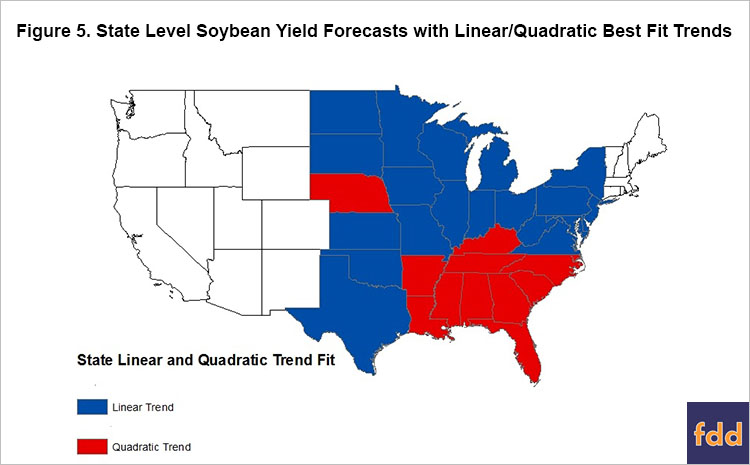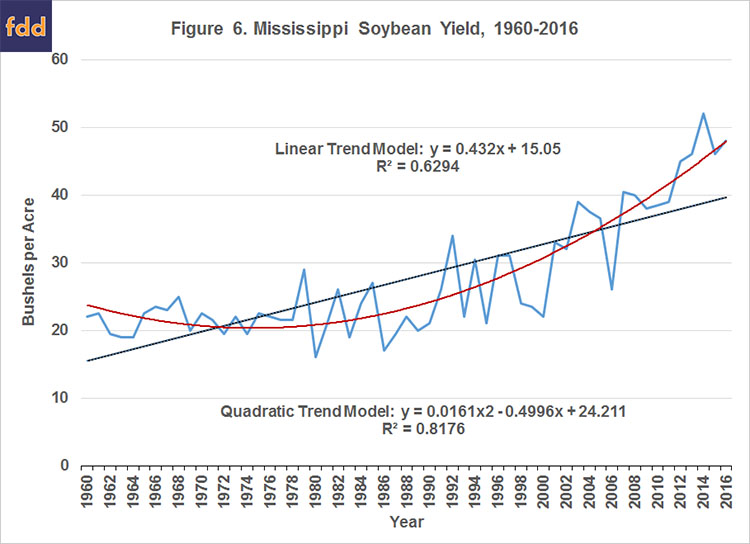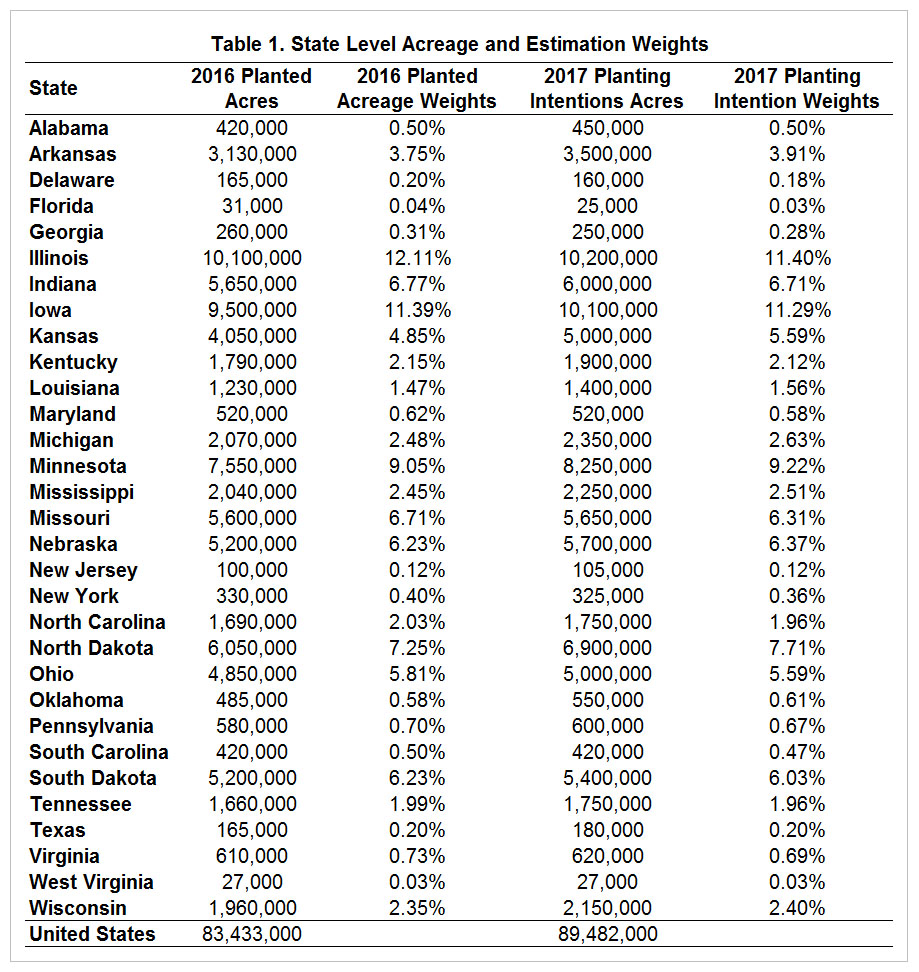Will the Shift in Soybean Acreage Impact National Yield in 2017? A State-Level Trend Analysis
USDA’s release of the March Prospective Planting report indicated an increase in planted acreage for soybeans in 2017. At a record high of 89.5 million acres, the report shows approximately 6 million additional acres of soybeans planted above last year and presents a possibility of record production in soybeans in 2017. The expansion of soybean acreage in the Prospective Plantings reports consisted of increases in many areas of the country with record levels of soybean planting intentions in the Western Corn Belt and Plains states. The size of the prospective soybean production in 2017 depends on the average yield for the crop which consists of many factors that will unfold over the next few months. Yield expectations are typically based on trend yield analysis, but recent above-trend yields combined with expanded acreage in lower yielding states raises the possibility of additional yield uncertainty in 2017. To address this issue, we first estimate trend yields for soybeans in states measured by the USDA. We then calculate a national trend yield estimate by weighting each state trend yield estimate by the percentage of acreage in that state in both 2017 and 2016. The difference in the two national trend yield calculation for the two weightings gives an indication of the potential yield impact of the acreage shift in 2017.
Soybean Trend Yield and Planting Intentions
U.S. national average soybean yield from 1960-2016 is provided in Figure 1. The figure contains a linear trend indicating yield increases 0.42 bushels per acre a year over the period. The linear trend fit explains 88.6 percent of the variation in annual average yields. Previous discussions of soybean yield expectations can be found in earlier work on forming trend expectations (e.g., farmdoc daily, March 19, 2015; March 9, 2016). Despite the good fit, a noticeable deviation from trend occurred during 2014-2016. National average soybean yield exceeded trend yield expectations significantly and brought into question the veracity of linear trend analysis when forming 2017 yield expectation. By using the best fit in capturing variation from the trend yield, the quadratic trend shown in Figure 2 provides a better fit to the historical data. While it is too early to determine if the recent positive deviations from trend imply a structural change in national average soybean yields (farmdoc daily, October 25, 2016), the increase in planting intentions in many states raises some questions about the true potential size of national average yields for soybeans in 2017.


The increase in planting intentions for soybean acreage in various states is shown on the map created by NASS in Figure 3. States in the Northern Plains and western Corn Belt are expected to have substantial growth in soybean planting intentions for 2017. Major producing soybean states intend to increase soybean acreage, with Iowa, Indiana, and Minnesota showing considerable increases. The increase in soybean planting intentions within states which traditionally do not produce large soybean yields raises the possibility of a lower national soybean yield for 2017. We investigate the implications of shifting soybean acreage by estimating soybean yield trends for each state and then calculate a national soybean yield using planted acreage weights for 2016 and planting intentions weights for 2017 by state.

State Level Soybean Yields and Trends
State level soybean yields from 1960-2016 for each state estimated by NASS were collected. All states except New York and West Virginia had data over the full period. New York lacked data from 1981 – 1997. West Virginia’s soybean yield data is available from 2000-2016. For both of these states, trends are calculated with the data available.
A linear trend for each state’s yields is fit to the data and a 2017 yield is projected for each state based on the trend. Figure 4 provides a map of expected linear trend yields for each state in 2017. The prospective yields show the regional variations in soybean yields with the largest yield expectations in the Corn Belt. The Southern states tend to have lower trend yields as would be expected. While linear trend yields for soybeans at the national level have provided the best fit over time, state level yields in some areas are better explained by quadratic trend. Consequently, we test whether each state soybean yield data is better fit with a linear or quadratic trend.

In assessing whether a state has a quadratic fit for yield trend, we assume a state possesses a quadratic trend if the coefficient on the quadratic trend variable is statistically significant. Figure 5 provides a map indicating the best trend model (linear or quadratic) in each state. States in red possess a quadratic fit. The map shows the southern states along with Nebraska have quadratic yield trend fits over the sample period. Figure 6 provides a representative example of the differences between the linear and quadratic trend fit models using Mississippi soybean yield data. Many of the southern states possess a similar type of soybean yield trend, which raises the interesting question of what has been driving the rise in these trend yield growth rates the last twenty years.


National Soybean Yield Estimates
To assess the potential impact of the shift in soybean acreage on national yield, we analyze how the two trend models for each state (linear trend model and best fit linear/quadratic trend model) impact national trend calculation using 2016 planted acreage and 2017 planting intentions. Table 1 provides each states’ acreage and weight for 2016 planted acreage and 2017 planting intentions. The data shows the changes in a state’s proportion of the national soybean crop in 2017 planting intentions are small. The largest increases are in Arkansas, Minnesota, Nebraska, and North Dakota. If linear trend estimates for each state are used to calculate national yield, 2016 planted acreage weights indicate a national yield at 45.6. By using 2017 planting intentions acreage weights, the 2017 trend yield is 45.5. The shift contained in the 2017 planting intentions report will reduce the national trend yield by 0.1 bushels per acre, which equates to approximately seven million bushels. When the best fit model for each state is used to calculate the 2017 trend yield, 2016 planted acreage weights indicate a national yield at 46.8. By using 2017 planting intentions acreage weights, the 2017 trend yield is 46.7. The change to 2017 acreage weights again indicates only a 0.1 bushel per acre. The small changes in possible trend yield demonstrate that the shifting nature of soybean planting alone is very unlikely to cause a significant change in the national average yield.

Implications
The substantial increase in planting intentions for soybeans in 2017 raises the possibility of a large soybean crop this year. The implications of yield expectations on soybean prices will be pronounced. While many areas increasing soybean acreage do not have historically high yield potentials, the suggestion that the national trend yield for soybeans will be reduced due to this factor is not supported by our analysis using state-level trend models and acreage weighting. The relatively small 2017 adjustments to national average soybean trend projections when considering the acreage shifts associated 2017 planting intentions indicates the use of national trend yield analysis is still the most practical method for forming expectations.
References
Irwin, S., and D. Good. "Forming Expectations for the 2015 U.S. Average Soybean Yield: What Does History Teach Us?" farmdoc daily (5):51, Department of Agricultural and Consumer Economics, University of Illinois at Urbana-Champaign, March 19, 2015.
Irwin, S., and D. Good. "Forming Expectations for the 2016 U.S. Average Soybean Yield: What About El Niño?" farmdoc dail (6):46, Department of Agricultural and Consumer Economics, University of Illinois at Urbana-Champaign, March 9, 2016.
Schnitkey, G. "Soybean Yields in Illinois." farmdoc daily (6):201, Department of Agricultural and Consumer Economics, University of Illinois at Urbana-Champaign, October 25, 2016.
USDA, National Agricultural Statistics Service. Quick Stats Ad-hoc Query Tool, accessed April 19, 2017. https://www.nass.usda.gov/Quick_Stats/
USDA, National Agricultural Statistics Service. Prospective Plantings (March 2017). http://usda.mannlib.cornell.edu/usda/nass/ProsPlan/2010s/2017/ProsPlan-03-31-2017.pdf
Disclaimer: We request all readers, electronic media and others follow our citation guidelines when re-posting articles from farmdoc daily. Guidelines are available here. The farmdoc daily website falls under University of Illinois copyright and intellectual property rights. For a detailed statement, please see the University of Illinois Copyright Information and Policies here.







